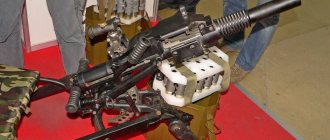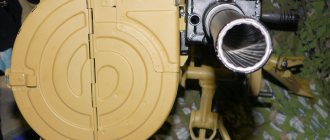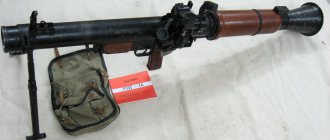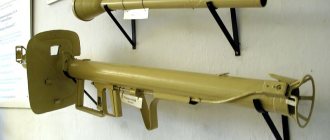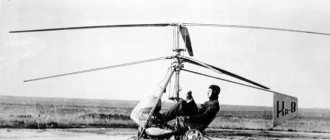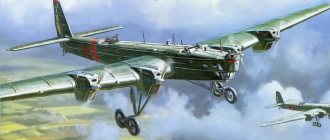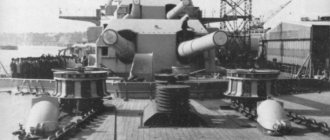AGS-17 “Plamya” is a Soviet easel automatic grenade launcher, which was developed at OKB-16 (now the Nudelman Design Bureau), and put into service in 1970. It is intended to destroy enemy infantry located both openly and behind natural folds of the terrain (on the reverse slopes of heights, in ravines, hollows), as well as in open field fortifications (trenches, rifle cells). The caliber of the AGS-17 grenade launcher is 30 mm.
The AGS-17 “Plamya” mounted grenade launcher is a powerful anti-personnel weapon with excellent tactical and technical characteristics. It can hit the enemy with both overhead and flat fire. The grenade launcher is still in service with the Russian army, in addition, the AGS-17 is used in the armed forces of another two dozen countries around the world (former Soviet republics, China, Iran, India, Finland, North Korea and others).
The strengths of the AGS-17 are its simplicity, reliability and versatility - the grenade launcher can be used not only from the machine, but also installed on various types of military equipment, including helicopters.
AGS-17 “Flame” is a formidable and effective weapon, proven in dozens of conflicts. Afghanistan became his baptism of fire. This grenade launcher has proven itself well during combat operations in the mountains. The AGS-17 was “respected” not only by Soviet soldiers, the Mujahideen also used captured examples of this weapon with great pleasure. The AGS-17 went through the first and second Chechen campaigns and other local conflicts that broke out in the territory of the former Soviet Union; the grenade launcher is currently actively used in Syria.
Serial production of the AGS-17 automatic grenade launcher was launched at the machine-building plant; currently there are several modifications of this weapon. In addition, the AGS-17 was produced in China and the former Yugoslavia.
History of creation
The first automatic grenade launcher AG-TB was developed in the USSR by the talented gunsmith designer Taubin in the early 30s of the last century. The idea of combining the rate of fire of automatic weapons with the damaging effect of fragmentation ammunition seemed very successful. The new type of weapon interested the military, prototypes were made and tests were carried out.
The AG-TB grenade launcher even managed to take part in the Winter War. There were plans to install new weapons on combat boats, aircraft, and armored vehicles. But, in the end, the 50-mm Shavyrin mortar was adopted, and work on automatic grenade launchers was stopped.
True, thanks to the AG-TB project, OKB-16 appeared, headed by Yakov Taubin.
For a long time in the USSR, automatic grenade launchers were not given due attention. Only after the Americans successfully began using the Mk 19 automatic mounted grenade launcher in Vietnam did the Soviet military think about creating an analogue.
The development of the grenade launcher was entrusted to the same OKB-16, however, at that time it was no longer led by Taubin, but by his student and follower Nudelman. The project was headed by Alexander Fedorovich Kornyakov.
In 1967, a firing model of the weapon was ready, it was called AGS-17. After some modifications and testing, in 1971 the Soviet army adopted a new type of small arms.
It should be noted that, structurally and according to the classification established in the Soviet Union, the AGS-17 “Plamya” is a small-caliber automatic weapon. Accordingly, his shot is a small-caliber artillery cartridge with a high-explosive fragmentation projectile. The name of the weapon (“automatic grenade launcher”) is more related to the tactical tasks it performs on the battlefield and is not determined by its design. Together with under-barrel launchers, automatic grenade launchers formed a new class of weapons - “support weapons.”
In combat conditions, the AGS-17 was used for the first time during the Vietnamese-Chinese conflict in 1979. The real test for this weapon was the war in Afghanistan, and it must be said that the AGS-17 passed it brilliantly. There were often cases when they independently welded “Plamya” grenade launchers to the body of armored vehicles, significantly increasing its combat power.
The first modifications of the weapon had a barrel with an aluminum radiator for cooling; later, fins on the outer surface of the barrel began to perform its functions.
Main shooting table
Sight scale "thousands"
OG grenade - 17
VMG fuze
Initial speed 185 m/s
| Range | Aim | Path height | Amendments | ||||||
| directions | range | ||||||||
| for derivation | on a side wind with a speed of 10 m/s | longitudinal speed 10 m/s | for changes | ||||||
| air pressure by 10 mm | air temperature by 10°C | initial speed by 1% | charge temperature by 10°C | ||||||
| m | thousand | m | thousand | thousand | m | m | m | m | m |
| 50 | 2 | 0,1 | 0 | 1 | 0 | 0 | 0 | 1 | 0 |
| 100 | 9 | 0,4 | 0 | 1 | 0 | 0 | 0 | 2 | 1 |
| 150 | 17 | 0,9 | 0 | 2 | 1 | 0 | 0 | 3 | 1 |
| 200 | 25 | 1,6 | 1 | 3 | 2 | 0 | 1 | 4 | 2 |
| 250 | 33 | 2,6 | 1 | 4 | 3 | 0 | 1 | 5 | 3 |
| 300 | 41 | 3,8 | 1 | 5 | 4 | 0 | 2 | 5 | 3 |
| 350 | 49 | 5,3 | 1 | 5 | 5 | 0 | 2 | 6 | 4 |
| 400 | 58 | 7,1 | 1 | 6 | 6 | 1 | 9 | 7 | 4 |
| 450 | 67 | 9,1 | 1 | 6 | 7 | 1 | 3 | 8 | 4 |
| 500 | 76 | 11 | 1 | 7 | 8 | 1 | 3 | 9 | 5 |
| 550 | 86 | 14 | 1 | 8 | 9 | 1 | 3 | 9 | 5 |
| 600 | 96 | 17 | 2 | 8 | 11 | 1 | 4 | 10 | 6 |
| 650 | 106 | 21 | 2 | 9 | 13 | 1 | 4 | 10 | 6 |
| 700 | 116 | 25 | 2 | 9 | 15 | 2 | 5 | 11 | 7 |
| 750 | 127 | 29 | 3 | 10 | 17 | 2 | 5 | 12 | 7 |
| 800 | 139 | 34 | 3 | 10 | 19 | 2 | 6 | 12 | 7 |
| 850 | 151 | 39 | 3 | 11 | 22 | 3 | 6 | 13 | 7 |
| 900 | 164 | 45 | 4 | 12 | 25 | 3 | 7 | 14 | 8 |
| 950 | 177 | 52 | 4 | 13 | 28 | 3 | 8 | 14 | 8 |
| 1000 | 191 | 60 | 5 | 14 | 31 | 4 | 9 | 15 | 8 |
| 1050 | 206 | 69 | 5 | 15 | 34 | 4 | 10 | 15 | 8 |
| 1100 | 221 | 79 | 6 | 16 | 37 | 4 | 11 | 16 | 9 |
| 1150 | 237 | 89 | 6 | 17 | 40 | 5 | 12 | 16 | 9 |
| 1200 | 254 | 100 | 7 | 18 | 43 | 5 | 13 | 16 | 9 |
| 1250 | 273 | 112 | 7 | 19 | 47 | 5 | 14 | 17 | 10 |
| 1300 | 292 | 126 | 8 | 21 | 51 | 6 | 15 | 17 | 10 |
| 1350 | 313 | 142 | 8 | 22 | 56 | 6 | 16 | 18 | 10 |
| 1400 | 335 | 160 | 9 | 23 | 61 | 7 | 17 | 18 | 10 |
| 1450 | 359 | 180 | 10 | 24 | 66 | 7 | 18 | 18 | 11 |
| 1500 | 386 | 203 | 11 | 25 | 71 | 8 | 39 | 19 | 11 |
| 1550 | 417 | 231 | 12 | 27 | 77 | 8 | 21 | 19 | 11 |
| 1600 | 453 | 266 | 14 | 29 | 84 | 9 | 22 | 19 | 11 |
| 1650 | 496 | 309 | 16 | 32 | 92 | 9 | 23 | 20 | 12 |
| 1700 | 557 | 369 | 19 | 36 | 102 | 10 | 25 | 20 | 12 |
| 1730 | 667 | 481 | 24 | 41 | 117 | 10 | 26 | 19 | 11 |
| 1700 | 768 | 588 | 30 | 48 | 127 | 11 | 26 | 19 | 11 |
| 1650 | 833 | 654 | 35 | 53 | 131 | 10 | 26 | 18 | 10 |
| 1600 | 879 | 698 | 39 | 57 | 133 | 10 | 26 | 17 | 10 |
| 1550 | 917 | 733 | 43 | 60 | 135 | 10 | 25 | 17 | 10 |
| 1500 | 949 | 763 | 47 | 64 | 136 | 10 | 24 | 16 | 10 |
| 1450 | 978 | 789 | 51 | 67 | 136 | 9 | 23 | 15 | 9 |
| 1400 | 1005 | 811 | 54 | 71 | 136 | 9 | 23 | 15 | 9 |
| 1350 | 1029 | 830 | 58 | 74 | 136 | 9 | 21 | 14 | 8 |
| 1300 | 1052 | 847 | 62 | 78 | 136 | 9 | 21 | 13 | 8 |
| 1250 | 1074 | 861 | 66 | 82 | 135 | 8 | 21 | 13 | 8 |
| 1200 | 1094 | 873 | 70 | 87 | 135 | 8 | 20 | 13 | 7 |
| 1150 | 1113 | 883 | 75 | 91 | 134 | 8 | 19 | 12 | 7 |
| 1100 | 1131 | 891 | 80 | 96 | 134 | 7 | 18 | 11 | 7 |
| 1050 | 1149 | 898 | 85 | 101 | 133 | 7 | 18 | 11 | 6 |
| 1000 | 1167 | 905 | 90 | 106 | 133 | 7 | 17 | 10 | 6 |
| Range | Change in range when changing the aiming angle by one thousandth | Narrow fork (4 W) | Aiming angle | Angle of incidence | Final speed | Flight time | Median deviations | ||
| by range | in height | lateral | |||||||
| m | m | thousand | deg/min | hail | m/s | With | m | m | m |
| 50 | 6,6 | 1 | 0 08 | 0,4 | 181 | 0,3 | 1,9 | 0,0 | 0,0 |
| 100 | 6,5 | 1 | 0 34 | 0,9 | 177 | 0,5 | 2,1 | 0,0 | 0,0 |
| 150 | 6,4 | 2 | 1 01 | 1,4 | 173 | 0,8 | 2,4 | 0,1 | 0,0 |
| 200 | 6,2 | 2 | 1 29 | 1,9 | 169 | 1,1 | 2,7 | 0,1 | 0,1 |
| 250 | 6,1 | 2 | 1,58 | 2,4 | 165 | 1,4 | 3,1 | 0,1 | 0,1 |
| 300 | 5,9 | 2 | 2 28 | 3,0 | 161 | 1,7 | 3,5 | 0,2 | 0,1 |
| 350 | 5,7 | 3 | 2 58 | 3,6 | 158 | 2,0 | 3,9 | 0,2 | 0,2 |
| 400 | 5,5 | 3 | 3 29 | 4,3 | 154 | 2,3 | 4,3 | 0,3 | 0,2 |
| 450 | 5,3 | 4 | 4 01 | 5,0 | 151 | 2,6 | 4,7 | 0,4 | 0,2 |
| 500 | 5,1 | 4 | 4 34 | 5,7 | 148 | 3,0 | 5,2 | 0,5 | 0,3 |
| 550 | 5,0 | 5 | 5,04 | 6,4 | 144 | 3,3 | 5,7 | 0,6 | 0,3 |
| 600 | 4,8 | 5 | 5 54 | 7,2 | 141 | 3,7 | 6,2 | 0,8 | 0,4 |
| 650 | 4,6 | 6 | 6 21 | 8,1 | 318 | 4,1 | 6,8 | 1,0 | 0,4 |
| 700 | 4,4 | 7 | 6 59 | 9,0 | 135 | 4,5 | 7,4 | 1,2 | 0,5 |
| 750 | 4,2 | 8 | 7 39 | 9,9 | 132 | 4,9 | 8,1 | 1,5 | 0,6 |
| 800 | 4,0 | 9 | 8 21 | 11 | 129 | 5,3 | 8,8 | 1,8 | 0,6 |
| 850 | 3,9 | 10 | 9,05 | 12 | 127 | 5,7 | 9,6 | 2,1 | 0,7 |
| 900 | 3,7 | 11 | 9 51 | 13 | 124 | 6,1 | 10 | 2,5 | 0,8 |
| 950 | 3,6 | 13 | 10 39 | 14 | 121 | 6,5 | 11 | 2,9 | 0,9 |
| 1000 | 3,4 | 14 | 11 29 | 16 | 119 | 7,0 | 12 | 3,3 | 1,0 |
| 1050 | 3,2 | 16 | 12 21 | 17 | 116 | 7,5 | 13 | 3,7 | 1,0 |
| 1100 | 3,0 | 17 | 13 16 | 19 | 114 | 8,0 | 13 | 4,2 | 1,1 |
| 1150 | 2,8 | 19 | 14 14 | 20 | 112 | 8,5 | 13 | 4,7 | 1,2 |
| 1200 | 2,7 | 20 | 15 16 | 22 | 110 | 9,1 | 13 | 5,2 | 1,3 |
| 1250 | 2,5 | 21 | 16 22 | 24 | 108 | 9,6 | 13 | 5,8 | 1,4 |
| 1300 | 2,4 | 2,3 | 17 32 | 25 | 107 | 10 | 14 | 6,4 | 1,5 |
| 1350 | 2,2 | 25 | 18 46 | 27 | 105 | 11 | 14 | 7,1 | 1,6 |
| 1400 | 2,1 | 27 | 20 05 | 30 | 104 | 11 | 14 | 7,8 | 1,6 |
| 1450 | 1,9 | 30 | 21 31 | 32 | 102 | 12 | 14 | 8,6 | 1,7 |
| 1500 | 1,7 | 33 | 23 08 | 34 | 101 | 13 | 14 | 9,5 | 1,8 |
| 1550 | 1,5 | 37 | 25 00 | 37 | 100 | 14 | 14 | 11 | 1,9 |
| 1600 | 1,2 | 47 | 27 11 | 40 | 100 | 15 | 14 | 13 | 2,1 |
| 1650 | 0,8 | 75 | 29 47 | 44 | 100 | 16 | 15 | 15 | 2,4 |
| 1700 | 33 24 | 49 | 100 | 17 | 15 | 18 | 2,7 | ||
| 1730 | 40 00 | 56 | 102 | 20 | 16 | 24 | 3,4 | ||
| 1700 | 0,8 | 85 | 46 06 | 62 | 104 | 22 | 17 | 31 | 3,7 |
| 1650 | 1,1 | 58 | 50 00 | 65 | 106 | 23 | 16 | 34 | 3,7 |
| 1600 | 1,3 | 46 | 52 45 | 67 | 107 | 24 | 15 | 36 | 3,7 |
| 1550 | 1,5 | 39 | 55 00 | 69 | 108 | 24 | 15 | 38 | 3,7 |
| 1500 | 1,7 | 34 | 56 57 | 70 | 108 | 25 | 15 | 39 | 3,7 |
| 1450 | 1,9 | 30 | 58 42 | 71 | 109 | 26 | 14 | 43 | 3,8 |
| 1400 | 2,0 | 27 | 60 18 | 72 | 109 | 26 | 14 | 43 | 3,8 |
| 1350 | 2,2 | 25 | 61 46 | 73 | 110 | 26 | 14 | 45 | 3,9 |
| 1300 | 2,3 | 23 | 63 08 | 74 | 110 | 26 | 13 | 46 | 4,0 |
| 1250 | 2,5 | 21 | 64 25 | 75 | 110 | 26 | 13 | 48 | 4,1 |
| 1200 | 2,6 | 20 | 65 38 | 76 | 110 | 27 | 13 | 50 | 4,3 |
| 1150 | 2,7 | 18 | 66 47 | 76 | 110 | 27 | 12 | 52 | 4,4 |
| 1100 | 2,8 | 17 | 67 53 | 77 | 110 | 27 | 12 | 54 | 4,5 |
| 1050 | 2,9 | 16 | 68 57 | 78 | 110 | 27 | 12 | 56 | 4,6 |
| 1000 | 3,0 | 16 | 70 00 | 79 | 109 | 27 | 12 | 59 | 4,7 |
Description of design
The AGS-17 automatic system works by rolling back the free shutter. The use of such a scheme allows the short barrel length, weak propellant charge of the grenade and low muzzle energy of the ammunition. The design of a grenade launcher consists of the following elements: trigger mechanism, receiver, box with barrel, bolt, reloading mechanism, return springs.
AGS-17 has a rifled barrel that can be quickly replaced; it is attached to the receiver using a pin and a lock. The rectangular bolt of the grenade launcher is equipped with a rammer, which moves vertically, and a comb that removes the spent cartridge case. Inside the bolt there is a hydraulic recoil brake, which increases the automatic cycle, thereby increasing the accuracy and accuracy of fire. The brake consists of a cylinder with kerosene, a rod with a piston and a flange that prevents fluid from leaking out. When recoiling, the hydraulic brake rests against the butt plate of the weapon, and when moving forward, against special protrusions of the receiver.
There are two return springs in the shutter channel.
The AGS-17 receiver cover contains a reloading mechanism, consisting of a clip and a cable with a T-shaped handle. When the cable is pulled, the bolt is pulled back. When firing from the AGS-17, the reloading mechanism remains motionless.
The impact mechanism of the easel grenade launcher is of the trigger type. During the descent, the trigger hits the firing pin lever located in the bolt. The trigger mechanism is located on the left side of the receiver.
AGS-17 is equipped with a flag-type fuse that locks the trigger sear. The grenade launcher has a mechanism for adjusting the rate of fire. It works by changing the duration of the weapon's automatic operation cycle.
The flag, with which you can change the rate of fire, has two fixed positions: top – 350-400 rounds/min. and lower - 50-100 shots/min. To control the AGS-17 grenade launcher, two horizontal folding handles are used, with a trigger lever located between them.
The AGS-17 has a belt feed; the grenade launcher’s belt is a link, metal, with an open link. It fits into a round-shaped box, which is attached to the right side of the receiver. The tape feeding mechanism consists of a spring-loaded feeder and a feed lever with a roller. The used cartridge case is extracted from the receiver using a special reflector downwards.
The shooting tape is loaded either manually or using a special machine. The box holds a standard 29 shot belt. The tape capacity is 30 shots, but it does not have a shank, so its role is played by the outermost link, which is inserted into the receiver.
The tape box has a carrying handle, a lid and a flap with latches, as well as a special curtain that closes the neck during transportation.
To aim the weapon, the PAG-17 optical sight is used, which is installed using a bracket on the left side of the receiver. Sights allow direct fire at a distance of 700 meters, and they can also be used when firing from closed positions. In addition to the optical one, the grenade launcher is also equipped with a mechanical sight, which consists of a front sight and rear sight.
To install AGS-17, the SAG-17 machine is used. In the stowed position, the SAG-17 folds and is usually moved by the second crew number. All machine supports are adjustable, which makes the use of the grenade launcher convenient in any situation.
For firing, the AGS-17 can use several types of shots, the most commonly used are VOG-17 and VOG-17M. Each of these shots consists of a cartridge case, a powder charge, a grenade and a flash fuze. The grenade has a thin-walled body with a notched wire of rectangular cross-section laid inside. After the primer is pierced, the powder charge in the cartridge case ignites and a shot occurs. The fuse is armed only after 50-100 meters of flight, which ensures the safety of the crew.
VOG-17M is a modernized grenade equipped with a self-destruct mechanism. In addition to combat shots, the grenade launcher's ammunition can also include practical shots. For example, VUS-17, which instead of an explosive contains a pyrotechnic composition that produces orange smoke at the impact site. Training ammunition has also been created for the AGS-17.
Shots for the AGS-17 grenade launcher were developed at NPO Basalt. Several more types of ammunition were created by foreign companies.
Shot
Unlike ordinary people, artillerymen call a shot not only the physical process of pushing a charge out of the barrel by powder gases, but also the totality of items necessary for this. To fire from cannons and howitzers, you need shells with cartridges and primers, and sometimes (for large-caliber guns) bags of gunpowder. The standard shot for the AGS-17 grenade launcher is the VOG-17 grenade. In addition to this, additional ammunition has been developed (VOG-17M, VOG-30, differing in explosive weight). They consist of a cartridge case equipped with a propelling powder charge and a primer, as well as the grenade itself. In essence, these shots are no different from fragmentation artillery shells, with the exception of a rather small caliber (30 mm) and dimensions that are more likely to correspond to aircraft cannon ammunition, only with a rounded tip. Within a radius of seven meters, the grenade destroys all living things with fragments.
Modifications
Currently, there are several modifications of the AGS-17:
- AGS-17 "Flame". This is a basic modification of the weapon, which is installed on the SAG-17 tripod machine.
- AP-30 "Flame-A". An aviation modification of the grenade launcher, developed in 1980. This option differs from the basic one in the presence of an electric trigger, a shot counter, a slightly reduced rifling pitch in the barrel and a higher rate of fire. Accordingly, the AP-30 had to be equipped with a more massive barrel cooling radiator. This version of the grenade launcher was usually placed in a special hanging container.
- AG-17D. Modification installed on the Terminator infantry support fighting vehicle
- AG-17M. The marine version of the grenade launcher, which is intended for installation on boats, is also used on the BMP-3.
- KBA-117. A modification of the grenade launcher developed by Ukrainian designers from the Artillery Armament Design Bureau. It is part of the combat modules of armored vehicles and armored boats.
Aiming system
To aim an automatic grenade launcher at a target, an optical sight of the PAG-17 type is used. It is mounted on a bracket on the left side of the receiver. The device makes it possible to fire directly at a distance of 700 meters. It is also used for indirect fire. In addition to optics, the system also includes a mechanical sight consisting of a front and rear sight.
The gun is mounted on the SAG-17 machine. In the stowed position, it folds and moves with the second design number. All supports of the device are adjustable, which makes the use of the grenade launcher convenient, regardless of the situation and terrain.
Exploitation
The AGS-17 crew consists of two people; the crew may also include an ammunition carrier. As a rule, shooting is carried out in automatic mode, although single fire can also be fired. The most effective is firing in short bursts (3-5 grenades).
In combat, the grenade launcher is moved together with the machine; for this, you can use special belts. It should be noted that this weapon weighs a lot - 18 kg, and together with the machine - 52 kg. And this is not counting the ammunition of the grenade launcher. This fact can be called the main disadvantage of the grenade launcher. In general, we can say that the AGS-17 is a reliable and effective weapon that is quite easy to operate. Its disassembly does not require additional tools and can be carried out in the field. All of the above qualities have been repeatedly tested during many wars and conflicts of recent decades. In most of its characteristics, the AGS-17 confidently surpasses its foreign analogues.
Machine SAG-17
The first modification was a system mounted on a relatively low tripod supporting a box consisting of two parts (upper and lower). In addition to the main function, the machine also performs an additional one: it serves as a supporting structure for the illumination batteries used for shooting at night. At the top of the device there are two cradles, upper and lower. The first is designed for direct installation of a grenade launcher using trunnions and has the ability to swing horizontally. There is also a latch connecting the cradle with the AGS-17 earring. The lower one provides horizontal guidance within the firing sector and supports the mechanism of the vertically swinging part. The entire tripod, together with the machine, consisting of two cradles, is unified and has the name SAG-17.
Characteristics
Below are the performance characteristics of the AGS-17.
| Caliber, mm | 30 |
| Barrel length, mm | 290 |
| Total length, mm | 840 |
| Total weight, kg | 18 |
| Weight with machine, kg | 52 |
| Rate of fire, rds/min | 65 |
| Radius of continuous damage, m | 7 |
| Rate of fire, rds/min | 100 |
| Initial speed of the grenade, m/s | 120 |
| Combat crew, people | 2-3 |
| Sighting range, m | 1700 |
Sight settings table
| Setting the sight (aiming angle in thousandths) when shooting with a hinged trajectory | Firing range, m | Setting the sight (aiming angle in thousandths) when shooting with a flat trajectory |
| 50 | 0-02 | |
| 100 | 0-09 | |
| 150 | 0-17 | |
| 200 | 0-25 | |
| 250 | 0-33 | |
| 300 | 0-41 | |
| 350 | 0-49 | |
| 400 | 0-58 | |
| 450 | 0-67 | |
| 500 | 0-76 | |
| 550 | 0-86 | |
| 600 | 0-96 | |
| 650 | 1-06 | |
| 700 | 1-16 | |
| 750 | 1-27 | |
| 800 | 1-39 | |
| 850 | 1-51 | |
| 900 | 1-64 | |
| 950 | 1-77 | |
| 11-67 | 1000 | 1-91 |
| 11-49 | 1050 | 2-06 |
| 11-31 | 1100 | 2-21 |
| 11-13 | 1150 | 2-37 |
| 10-94 | 1200 | 2-54 |
| 10-74 | 1250 | 2-73 |
| 10-52 | 1300 | 2-92 |
| 10-29 | 1350 | 3-13 |
| 10-05 | 1400 | 3-35 |
| 9-78 | 1450 | 3-59 |
| 9-49 | 1500 | 3-86 |
| 9-17 | 1550 | 4-17 |
| 8-79 | 1600 | 4-53 |
| 8-33 | 1650 | 4-96 |
| 7-68 | 1700 | 5-57 |
| 6-67 | 1730 | 6-67 |
Aviation option
The high efficiency of the fire weapon prompted the designers of the bureau named after. Nudelman to consider other options for its application. In 1980, the 213P-A helicopter complex was put into service, which is an AGS-17 automatic grenade launcher located in an overhead container (GUV, i.e., a universal helicopter gondola), installed on the external suspension units of attack helicopters. Aviation specifics required certain design changes. The GUV contains ammunition consisting of three hundred shells. The weapon, unlike the infantry version, is activated remotely via an electric drive. A sharp increase in the rate of fire (up to 500 versus the usual 65 rounds per minute) caused, in turn, the need to cool the barrel, implemented by an air radiator. The barrel has also undergone changes in terms of the cutting pitch. The initial speed, increased due to the movement of the system, required more intense rotation of the grenade to ensure the required accuracy of the hit.
Disassembly and assembly of the hydraulic rate of fire regulator and hydraulic brake of the grenade launcher
1. Disassembly of the hydraulic rate of fire regulator is carried out in repair shops in the event that the grenade launcher loses the minimum rate of fire in order to refuel it with kerosene and replace worn parts.
Disassemble in the following order (Fig. 25):
— unscrew the locking screw securing the regulator handle to the needle and remove the handle from the needle;
- use a punch to push out the pin connecting the needle to the rod and separate the needle and spring;
— pour kerosene through the needle channel and remove the rubber ring;
— knock out the pin and unscrew (first from one side) the seal nut with the ring and the seal body with the support ring and rubber ring; carefully separate the rod and mainspring;
— remove the bushing, fluoroplastic ring, rubber ring, retaining ring, bushing, spring and valve from the rod;
— Unscrew the seal nut and the seal body with the support ring from the other side.
After eliminating the identified deficiencies, assembly is carried out in the following order:
— screw the seal housing on the front side of the striker, insert the rubber ring and support ring into the sockets of the seal housing; insert the ring into the socket of the seal nut and screw the nut into the striker until the holes in the housing and the nut coincide;
— hammer a pin into the firing pin hole and core it at three points on both sides;
— put the valve, spring, bushing on the rod, securing it with a locking ring, rubber ring, fluoroplastic ring and bushing;
— insert the rod into the hammer so that the end of the rod comes out through the seal;
— insert the mainspring into the firing pin and, squeezing it, screw the seal housing until it stops;
— insert the rubber ring and support ring into the seal body and screw the seal nut so that the holes in the body and nut are aligned;
— pour 36 cm3 of filtered kerosene through the hole in the rod into the internal cavity of the firing pin body;
- put a ring on the rod and a spring on the needle; insert the needle into the axial channel of the rod and connect them with a pin;
— put the handle on the needle and secure it with the locking screw.
2. Disassembly of the hydraulic brake (Fig. 22) is carried out only in repair shops if a kerosene leak is detected through the seal to refill the hydraulic brake with kerosene and replace worn parts.
Disassemble in the following order:
- knock out the seal pin with a punch, unscrew the seal assembly and separate the rod with the seal;
- pour kerosene out of the bolt hole and remove the sleeve;
- knock out the pin securing the nut to the rod, unscrew the nut and separate the flange;
— knock out the seal assembly pin, unscrew the seal nut and separate the support ring, seal rings and seal body.
After eliminating the identified deficiencies, assembly is carried out in the following order:
— insert the rubber ring and support ring into the seal body; insert a ring into the socket of the seal nut and screw the nut into the seal body until the holes in the nut and the body align;
— hammer a pin into the housing hole, put a ring on the seal and put the seal assembly on the rod;
— put a flange on the rod, screw the nut until the holes in the rod and nut are aligned, secure the nut with a pin and tighten the pin on both sides;
— insert the sleeve into the shutter hole so that the long tapering part of its windows faces forward: pour 88 cm3 of filtered kerosene into the shutter hole;
— move the seal on the rod so that there is a gap of no more than 20 mm between the seal and the flange; insert the rod into the valve hole and screw the seal into the valve hole, aligning the holes for the pin in the valve and the seal body; connect the seal body and the valve with a pin and flare the pin. If the pin was damaged during disassembly, replace it with a new one,
Related microtransactions
| Item | Effect(s) |
| Celestial Flame Blast Celestial Flame Blast Effect Flame Blast Effect Your Flame Blast becomes a Celestial effect. | Your Flame Blast becomes a Celestial effect. |
| Harbinger's Flame BlastHarbinger's Flame Blast EffectInferno Blast EffectYour Flame Blast gains a blue Harbinger effect. | Your Flame Blast becomes a blue Harbinger effect. |
| Flame Demon BlastFire Demon Blast EffectFlame Blast EffectStack Size: 20Your Flame Blast becomes a powerful blast of demonic energy | Your Flame Explosion becomes a powerful blast of demonic energy. |
Receiving an item
Methods of obtaining
This item can be obtained in the following ways:
| Qty | Ingredient | General Notes | Type |
| 8 | Deadly melancholy
| random skill gem level 19 and quality 19 | Automatically |
| 1 | Stonecutter IncubatorGemcutter IncubatorAdds an incubated quality skill gem to an equippable item.Item drops after killing %1% monsters.Quality skillstoneRight click this item then left click an item to apply it. The incubated item will drop after killing a certain number of monsters. | random skill gem of random quality | Automatically |
| 6 | Fox
| random level 20 stone | Automatically |
| 13 | Cataclysm
| random corrupted stone with the “Enchantment” tag, level 21 | Automatically |
| 3 | Stonecutter's Oath
| random stone with quality 20 | Automatically |
Used to obtain
This item is used to obtain the following items:
| Result | Qty | Ingredient | General Notes | Type |
| Vaal Flame BlastVaal Flame BlastVaal, Spell, AoE, Fire, ChannelingOne Soul Cost: 30 (N) / Max Charges: 1Unable to Gain Souls: 6.000 secCasting Time: 0.50 secCritical Strike Chance: 5.00%Added Damage Effectiveness: 60%Required Level 28 The hero indicates the area in which a powerful explosion begins to prepare. The speed at which the explosion is prepared is based on the casting speed of the spell. An explosion occurs every 3 stages until it reaches 15 stages. Each stage reduces the area of effect, but increases the damage.Per 1% Quality:1% increased DamageDeals (31-280) to (46-419) Fire Damage110% more Spell Damage per stage90% more Damage from conditions per stage +5% chance to ignite per stage -1 to radius per stage CorruptedPlace into an item socket of the right color to gain this skill. Right-click to remove the stone from its socket. | 1 | Flame BlastFlame BlastSpell, AoE, Fire, ChanneledMana Cost: (4-7)Cast Time: 0.20 secCritical Strike Chance: 5.00%Added Damage Effectiveness: 60%Requires Level 28Channel a skill to create a large explosion. The longer the channel lasts, the wider the effect and the more damage the explosion will deal, up to 10 stages.Per 1% Quality:1% increased DamageDeals (31-280) to (46-419) Fire Damage110% more Fire Damage enchantments per stage90% more damage from conditions per stage+5% chance to ignite per stage+3 to radius per stagePlace into an item socket of the appropriate color to gain this skill. Right-click to remove the stone from its socket. | random desecration result | Manually |
| 1 | Vaal OrbVaal OrbStack Size: 10Corrupts an item, changing it unpredictablyRight click this item then left click an item to corrupt it. Corrupted items cannot be modified again. Shift-click to separate. |
Mission reward
Given as a reward for the following tasks:
| Class → | Witch | Bandit | Huntress | Duelist | Savage | Priest | Noblewoman |
| Task ↓ | |||||||
| Cutting off the right hand Act 3 | ✓ | ✗ | ✗ | ✗ | ✗ | ✓ | ✓ |
Merchant's Reward
Can be purchased from the listed merchants after completing the following quests:
| Class → | Witch | Bandit | Huntress | Duelist | Savage | Priest | Noblewoman |
| Task ↓ | |||||||
| Cutting off the right handAct 3Clarissa | ✓ | ✓ | ✗ | ✗ | ✓ | ✓ | ✓ |
| The Unraveling of FateAct 3Sios | ✓ | ||||||
| Fallen from Grace Act 6 Lily Roth | ✓ |
3. General structure of the shot for the Ags-17, the concept of the operation of its parts and mechanisms.
To fire from the AGS-17, a 30-mm shot with a VOG-17 fragmentation grenade is used.
The VOG-17 SHOT consists of a FRAGRATION GRENADE, a POWDEPOW CHARGE and an INSTANT MAIN FUSE (IMG).
Fragmentation grenade - to destroy manpower with fragments; consists of a body, a driving belt, a spring (fragmentation jacket) and a bursting charge.
Powder charge - to impart initial speed to the grenade; consists of a cartridge case, primer-igniter and nitroglycerin powder.
Head fuse - to ensure the grenade explodes when it meets a target (obstacle); consists of impact and ignition mechanisms and a long-range cocking safety mechanism.
The impact mechanism ensures that the VMG is triggered when it encounters an obstacle.
The ignition mechanism ensures that the safety mechanism is activated.
The long-range cocking safety mechanism ensures the safety of the VMG in official use and long-range cocking. The fuse mechanisms are located in a sleeve with an axis that presses the membrane.
The fully loaded shots are placed in paper cartridges and placed in sealed metal boxes of 48 pieces. In the box: 2 boxes, a knife for opening boxes, instructions for using the knife.
Markings are applied with black paint on the walls and lid of the box, on the lid of the metal box and on the grenade.
Grenades in combat equipment are painted black.
TAPE for SHOTS - used to place shots and feed them into the grenade launcher receiver; consists of separate pieces of 10 links each. Pieces of tape are connected to each other using a shot, links using cotter pins. The link has: front and rear grips, a shank, a connecting ring and a connecting protrusion. The tape is rigged manually or with a rigging machine.
BOX for SHOTS – serves to place a tape with 29 shots; it has a handle for carrying, a lid and flap closed with latches, a curtain for closing the neck of the box during transportation;
a clip with a hook and a tooth - for attaching the box to the AGS-17; inside - a spiral guide (snail) - to direct the movement of the tape; protrusion - to hold the tape.
A flurry of fragments
The AGS-17 automatic mounted grenade launcher, combining the rate of fire of a machine gun and the power of a fragmentation grenade, proved its qualities during the war in Afghanistan. It was used in infantry and installed as additional weapons on armored vehicles.
The modern version is the AGS-30, which is lighter than the old one (the body weight of the grenade launcher with the machine is 16 kg versus 31), and the new VOG-30 grenades have a more powerful fragmentation effect.
This grenade launcher is fed with ammunition from a box with a belt for 30 shots, the maximum range for mounted firing is from 1700 to 2200 m (depending on the ammunition used).
Squad leader firing record form
| (position title Last Name First Name Patronymic) |
| (firing position location) |
| Marking on aiming points: main......, spare......., night........ |
| Smallest sights: |
| Example entry |
| Team number | Team | Observation | ||||
| Target, order of fire | Firing range m | Aim | Goniometer (direction) | Grenade launchers | ||
| 2 | 1 | |||||
| 1 | On the machine gun, the first one, short fire | 1000 | 1-19 | 30-00 | — | r20 |
| 2 | Fire | — | — | -0-20 | — | P- |
| 3 | Fire | 1100 | 2-21 | — | — | n5++ |
| 4 | Separately, in one short, 10 second burst - fire | 1050 | 2-06 | -0-05 | l10++ | ++ |
| 5 | Second, to the right 0-10, squad, short - fire | 1025 | 1-98 | — | n5++ | c+- |
| 6 | Wait, write down the first goal | 1025 | 1-98 | 29-80 | ||
| Signature |
| (title Surname) |

